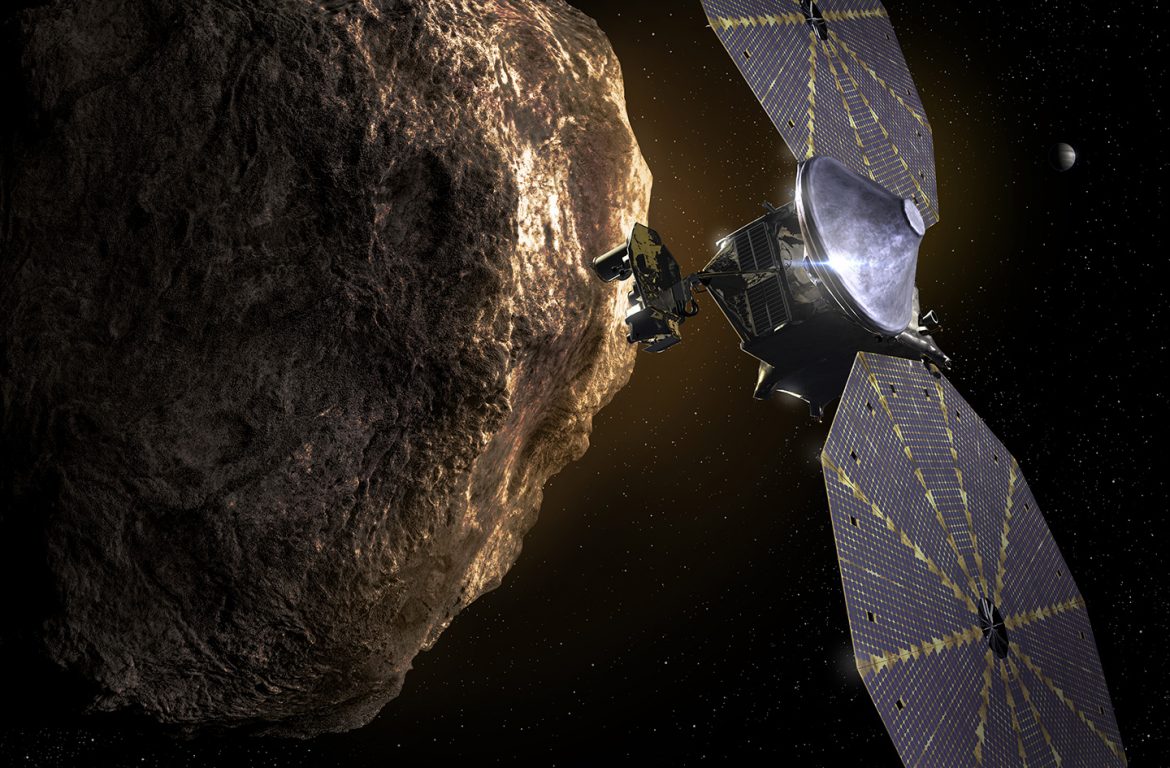The ambitious Lucy mission, which explores the trojan asteroids in our Solar System, will launch on October 16, 2021. Find out the incentives behind the mission, the components of the spacecraft, and what it will find out about our Solar System.
The Objectives of the Mission
The Lucy spacecraft will embark on a 12-year journey studying 8 asteroids after launching on Saturday. The asteroids to be visited are:
- 52246 Donaldjohanson
- 3548 Eurybates (and its small satellite)
- 15094 Polymele
- 11351 Leucus
- 21900 Orus
- 617 Patroclus/Menoetius
Out of the 8 objects visited, 7 of which are asteroids that orbit the Sun with Jupiter. These are called Jupiter trojan asteroids, along with others in similar locations. Some of them are 60 degrees ahead of Jupiter, near the L4 Langrange point. Others are near the L5 Langrange point between the Sun and Jupiter, 60 degrees behind Jupiter.
These trojan asteroids are great scientific targets because they are trapped in their current location for billions of years. Therefore, they can teach us a lot about the early history and formation of our Solar System. In fact, revolutionizing our understanding to the Solar System is the key to the Lucy mission, which is named after the famous fossil Lucy that provided important insights on human evolution.
The Lucy Spacecraft
Like in other missions, the spacecraft is an indispensable part of the mission because it’s what gets there and conducts measurements and investigations. One of its most obvious parts is two large hexagonal solar panels, which will power the spacecraft during its 12-year journey, including when it gets as far from the Sun as Jupiter. In fact, most of the spacecraft’s length is occupied by its enormous solar panels, which provide power to the main part of the spacecraft, which is between the two solar panels.
There are 4 instruments on Lucy:
- A thermal emission spectrometer (TES)
- a long-range reconnaissance imager (LORRI)
- a linear etalon imaging spectral array (LEISA)
- a multi-spectral visible imaging camera (MVIC)
Note that the TES and the LORRI are called the L’TES and the L’LORRI, respectively, in this mission.
The LORRI and the MVIC take photos of the asteroid, while the TES figures out the composition of the asteroids. On the other hand, The LEISA can detect different organic materials, silicates, and ices on the surface of these asteroids.
How Will It Get to the Asteroids?
You’ve already realized that the target is very far away from Earth, right? If so, it’s natural to ask how it will get there.
Firstly, the spacecraft will be put in an orbit to bring it back to Earth one year later. After the first Earth flyby in 2022, Lucy will rise to a two-year orbit around the Sun, after which it will be brought back to Earth in 2024, and the orbit will be raised. At this point, it’s on course for visiting Donaldjohanson in 2025, Eurybates and Polymele in 2027, and Leucus and Orus in 2028. After the spacecraft completes another orbit around the Sun, it will reencounter Earth in 2030 and use its gravity to refine its orbit, sending the spacecraft straight to the L5 point where Lucy will encounter Patroclus and Menoetius in 2033.
Conclusion
In this article, we’ve briefly explained the Lucy mission, which is launching this Saturday to explore 8 trojan asteroids in the span of 12 years. If you want to know more about this ambitious mission, please visit the websites in the references below.
References and Credits
- Meghan Bartels. (2021, October 14). NASA’s daring Lucy asteroid mission is ready to launch. Retrieved October 14, 2021, from https://www.space.com/nasa-lucy-asteroids-mission-ready-to-launch
- Karl Hille. (2020, December 3). The Lucy Spacecraft and Payload. Retrieved October 14, 2021, from https://www.nasa.gov/content/lucy-spacecraft-and-payload
- Lucy Mission. (2020, October 17). The Lucy Spacecraft and Payload. Retrieved October 14, 2021, from http://lucy.swri.edu/mission/Spacecraft.html
- Lucy Mission. (n.d.). Timeline. Retrieved October 14, 2021, from http://lucy.swri.edu/timeline.html

